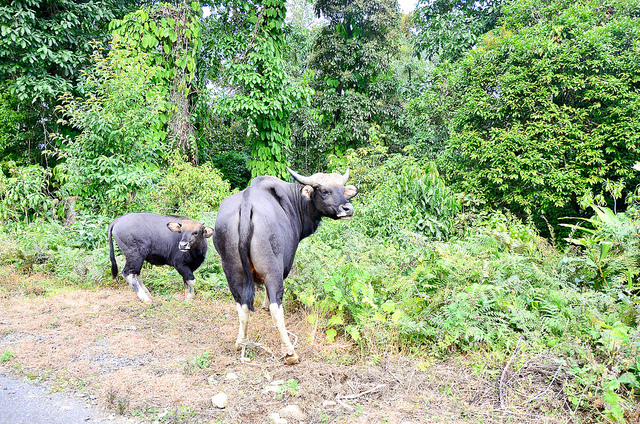Land of the Rising Sun

Image by gkrishna63
Located in the extreme north eastern part of India, Arunachal Pradesh is rightly called the ‘Land of the Rising Sun’ in India. It is the first state in India to get the morning light every day. It shares its borders with the countries of Bhutan to the west, China to the north-east, Myanmar to the east and states of Assam and Nagaland to the south.
Arunachal Pradesh finds its mention in the literature of Kalika Purana and the great Hindu Epic Mahabharata. It is believed to be the Prabhu Mountains of the Puranas. According to a Hindu mythological legend, Arunachal Pradesh was the place where sage Parshuram washed away his sin, sage Vyasa meditated, King Bhishmaka founded his kingdom and Lord Krishna married his consort Rukmini.
Known as the North East Frontier Agency (NEFA), the area was part of Assam until it was carved out as a union territory and renamed Arunachal Pradesh on January 20, 1972. Arunachal Pradesh became a full-fledged State on 20th February, 1987.
Covering an area of 83,743 sq. km., Arunachal Pradesh comprises two divisions i.e. East and West which are further divided into 25 districts. The three districts of, Pakke-Kesang, Lepa-Rada and Shi-Yomi were added in the year 2018.
With a total population of 1,382,611, Arunachal Pradesh is home to dozens of distinct ethnic groups. Arunachal Pradesh has a population density of 17 per sq. km which is the lowest in any state in India. In western Arunachal Pradesh the Nissi (Nishi or Dafla), Sherdukpen, Aka, Monpa, Apa Tani, and Hill Miri are among the main tribes. The Adi, who constitute the largest tribal group in the state, live in the central region. The Mishmi inhabit the northeastern hills, and the Wancho, Nocte, and Tangsa are concentrated in the southeastern district of Tirap. Other than the indigenous tribes, rest of the population of Arunachal Pradesh consists of immigrants from Bangladesh, as well as from Assam, Nagaland, and other states of India.
The tribal groups speak about 50 languages and dialects, most belonging to the Tibeto-Burman branch of the Sino-Tibetan language family. They are often mutually incomprehensible so Assamese, Hindi and English are used as the bridge language in the state. Each of the tribes follows its own social, cultural, and religious practices, and most are endogamous (marrying within the group). Many of the groups practice local religions that involve interaction with various spirits and deities of nature. Ritual sacrifice is common, and a domesticated gaur (wild ox), locally known as a mithun, is especially valued as a sacrificial animal.
Arunachal Pradesh’s terrain consists mostly of deep valleys flanked by highland plateaus and ridges that rise to the peaks of the Great Himalayas. There are three broad physiographic regions. Farthest south is a series of foothills, similar in type to the Siwalik Range (a narrow sub-Himalayan belt stretching across much of northern India), that ascend from the Assam plains to elevations of 1,000 to 3,300 feet (300 to 1,000 metres). Those hills rise rapidly northward to the Lesser Himalayas, where some ridges and spurs reach 10,000 feet (3,000 metres). Farther north, along the Tibetan border, lie the main ranges of the Great Himalayas, where Kangto, the highest peak in the state, dominates the landscape, reaching about 23,260 feet (7,090 metres).
The Brahmaputra and its tributaries—the Dibang (Sikang), Lohit, Subansiri, Kameng, and Tirap are the main rivers flowing in the state. As the river known as Tsangpo in the Tibet Autonomous Region of China enters Arunachal Pradesh, it is called Siang and makes a very rapid descend from its original height in Tibet, and finally appears in the plains, where it is called Dihang. It flows for about 35 km and is joined by two other major rivers Dibang and Lohit at a short distance beyond Pasighat, just south of the border between Assam and Arunachal Pradesh. From this point of confluence, the river becomes very wide and is called Brahmaputra. West of the Brahmaputra, the Subansiri is the only tributary to cross the main Himalayan ranges. The Kameng and other rivers in the area rise on the southern flanks of the mountains. The Tirap River drains the southeastern part of the state.
The climate of Arunachal Pradesh varies with topography and elevation. The regions in the lower belts of the state experience hot and humid climates, with a maximum temperature in the foothills reaching up to 40 °C (during the summer). The average temperature in this region in winter ranges from 15° to 21 °C while that during the monsoon season remains between 22° and 30 °C. The areas around the middle belt are relatively cooler. The middle belt experiences micro thermal climate. Moreover, an alpine climate is prevalent in the higher altitudes of the state. The higher regions witness snowfall during winter. Arunachal Pradesh experiences heavy rainfall during May to September. The average rainfall recorded is 300 centimeters, varying between 80 centimeters and 450 centimeters.
The high diversity in terrain, climate, and soil results in a high diversity in the flora and fauna of Arunachal Pradesh. About two-thirds of the state is forested, with a wide belt of swampy rainforest lying along the foothills. Forests of tropical evergreens and subtropical pines (as well as subtropical mixed broad-leaved and pine forests) are found in lower elevations. As elevation increases, the woodlands give way to mixed and coniferous temperate forests. Subalpine and alpine vegetation, with rhododendrons predominating, appears on the higher slopes. The different type of vegetation comprises of nearly 5000 species of angiosperm, 34 species of gymnosperm, 350 species of ferns and bryophytes along with other innumerable floral species.
The rich faunal biodiversity of Arunachal Pradesh comprises of 216 species of mammals, 119 species of reptiles, 53 species of amphibian, 218 species of pisces, and 770 species of birds along with many other unreported species. Of the mammals reported from as many as 37 species are categorized under Schedule-I of the Indian Wildlife (Protection) Act, 1972. Arunachal Pradesh is the only state in India where three goat antelopes namely Naemorhedus goral, N. sumatraensis and Budorcas taxicolar are found. Perhaps it is the only state that harbours four major cats namely Tiger (Panthera tigris), Leopard (P. pardus), Clouded Leopard (Neofelis nebulosa) and Snow Leopard (Uncia uncia). The highly endangered Hispid Hare has also been reported from D. Ering Wildlife Sanctuary, Pasighat.
Arunachal Pradesh is known as the ‘Orchid State of India’ and is home to around 600 species of orchids, known for their exquisitely beautiful blooms. It has the highest diversity of orchids in the country because of its topography. There are various kinds of forests – alpine, sub-alpine, temperate, tropical and sub-tropical leading to a flourishing of different species of orchids.
More than half of the population of Arunachal Pradesh is engaged in agriculture, but only a tiny portion of the land is under cultivation. Shifting or jhum cultivation continues to be prevalent in the hill areas. However, settled agriculture including wet-rice farming has expanded considerably since the late 20th century. Rice, corn (maize), millet, and buckwheat are among the chief crops in the state. Major commercial crops include oilseeds, potatoes, ginger, sugarcane, and vegetables. Mithuns are widely domesticated, and yaks are important in the higher elevations. The Monpa herd sheep. Some groups also raise fish through aquaculture.
The tribal groups in Arunachal Pradesh wear distinctive garments and headdress. The art of weaving is especially important, and textile designs are unique to each group. Dances are an integral part of community life. Losar, Mopin, and Solung are major tribal festivals. At such festivals, villagers often drink millet or rice beer, as well as tea.
There are various tourist attractions in the State. Places of worship and pilgrimage such as Parasuramkund and 400 years old Tawang Monastery, or the sites of archaeological excavations like Malinithan and Itanagar, the serene beauty of lakes such as Ganga lake or Sela lake or the numerous variations of scenic beauty of the snow clad silver mountain peaks and lush green meadows where thousands of species of flora and fauna prosper are some examples. In addition, the state provides abundant scope for angling, boating, rafting, trekking and hiking. Besides, there are a number of wild life sanctuaries and national parks where rare animals, birds and plants will fascinate the visitor. Nature has provided the people with a deep sense of beauty which finds delightful expression in their songs, dances and crafts.
Itanagar, the capital of Arunachal Pradesh is the largest town in the state. It derives its name from the Ita fort which is a major tourist attraction and one of the most important historical sites in the state of Arunachal Pradesh. The name literally means “fort of bricks”(bricks are called ita in Assamese language) The Ita Fort was built as early as the 14th or the 15th century by the kings of the Chutia dynasty. The Jawaharlal Nehru Museum and Ganga Lake (also known as Gekar sinyi) are other places of interest in the capital.
